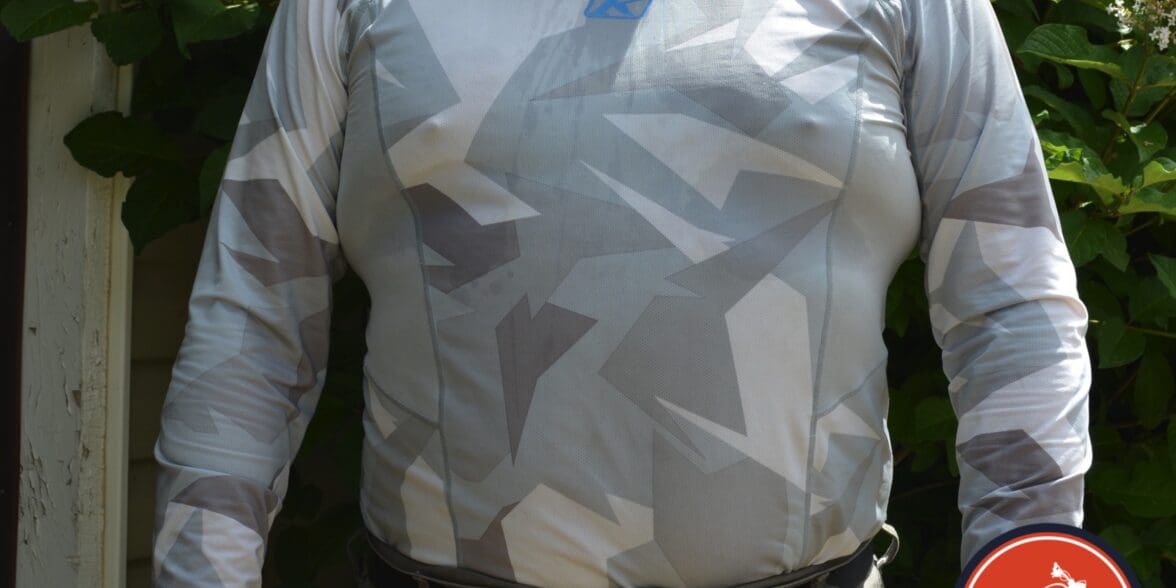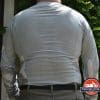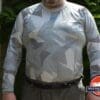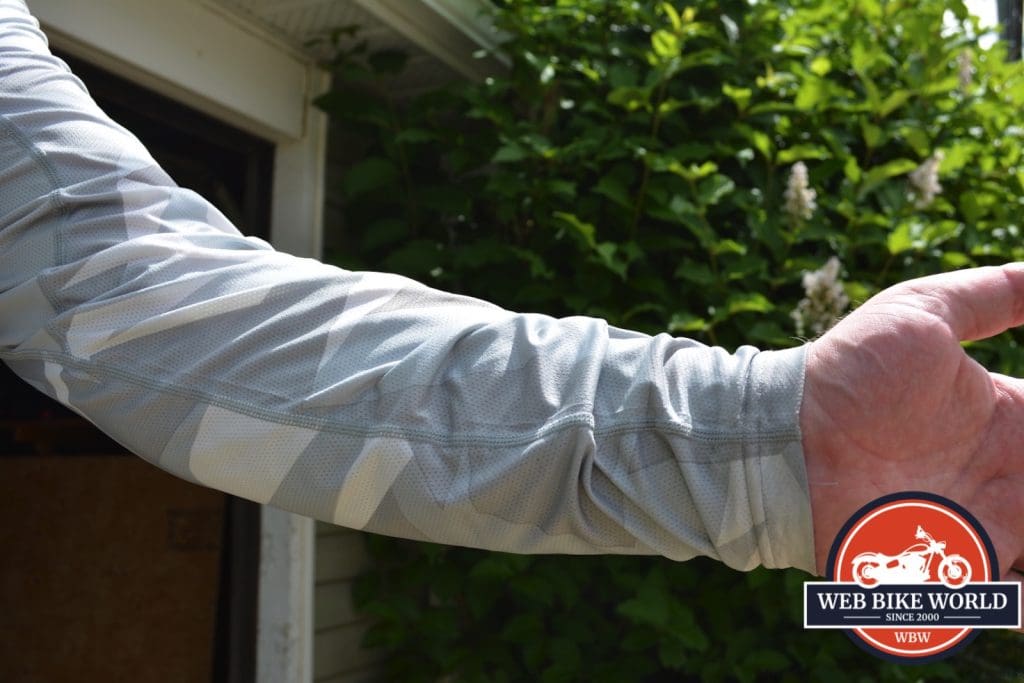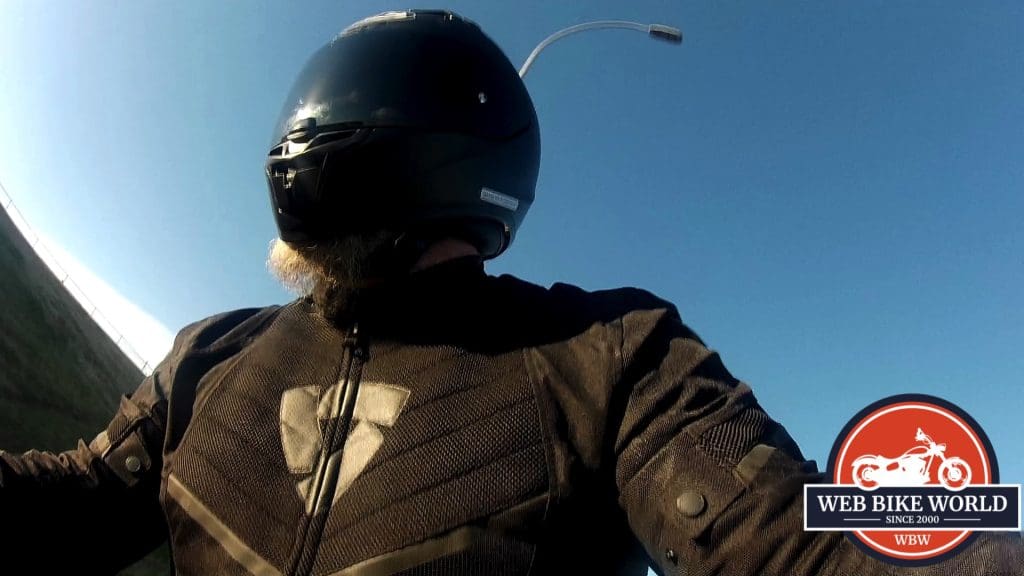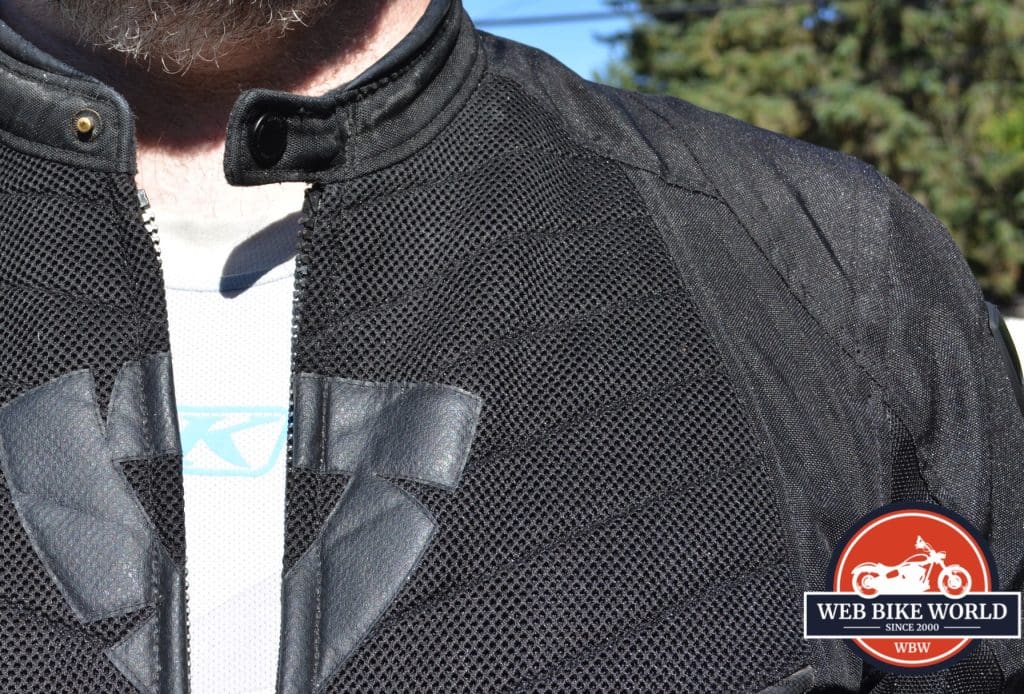Being relatively new to motorcycling, the idea of special base layers was a bit foreign to me. As a fan of Powersports, I knew that MotoGP and World SBK riders had their base layers to go under their one-piece leathers, and being familiar with the Dakar rally, I knew that multiple layers for riders was often the case. What I didn’t realize, however, was just what these base layers actually do.
While April and May here in Calgary, Alberta, Canada were relatively seasonal, with cool days and some warm ones that were easily handled with either my Alpinestars Andes V3 Touring Jacket or my Rev’It Arc Air Mesh jacket, things started to get a bit silly in June. Before it was announced as such, a massive heatwave was building throughout most of the month, with the last ten days of June 2021 breaking multiple temperature records across Canada and the USA. As I was wearing cotton t-shirts under my jackets, things were getting a little sweaty and, consequently, a touch smelly.
I was on the fence between getting one of the cooling vests you could soak in water to activate chemical compounds in their fibers to assist with cooling or using a compression shirt with sweat-wicking properties. After a little research and, honestly, a bit of luck, I acquired the KLIM Aggressor -1.0 Cooling Shirt, both as a thinner base layer and as something to help wick away the heat and sweat that form under proper motorcycle protective gear.
About KLIM
KLIM started out in 2008 as a maker of adventure motorcycle and snowmobile gear in Rigby, Idaho. From 2008 to 2012, it was its own company, gaining popularity and “adventure cred” with the off-road Powersports community. In 2012, Polaris Industries, owners of Indian Motorcycles and a snowmobile and adventure vehicle maker in their own right, bought out KLIM, making it a wholly-owned subsidiary.
Since then, with the investment that Polaris can leverage into research and development, KLIM has been at the forefront of adventure Powersports safety and gear. Through their continued push towards safety and tackling the great outdoors, Poron XRD non-Newtonian foam armor and the KLIM Powersports Airbag have been two of their most recent safety innovations.
About webBikeWorld’s Review Policy
This product was purchased by myself for this review to add to my personal gear. Note that we do not allow brands to influence review scores or content. Please see our review policies for more information.
We here at webBikeWorld believe that you can’t just try something out once and give an honest opinion of it. Any product we test is actually used by our testers, and for the month of June 2021, wny time I rode, hot or cold, I wore this base layer.
KLIM Aggressor -1.0 Cooling Shirt Features
Bike: 2012 Kawasaki Ninja 650
This is one of those pieces of motorcycle gear that you honestly hold out in front of you, looking at it and thinking, “Are they really sure that this will actively cool me?” The question popped into my head when I was doing just that because it honestly feels like any compression shirt you can buy at the local sports goods store. The only real difference to the eye and touch without it being worn are the lay-flat stitches that bring all the panels together, all of which feel high quality and are evenly spaced for maximum stretch without being ridiculously tight.
However, once you put the shirt on, the biggest feature of the Aggressor is immediately apparent. Without using any chemical agents to assist the process, the shirt fits tightly to the skin, and for just a moment, you feel a bit warm. Then, and this honestly had me utter something describing both a religious experience and a bodily function, that warmth was literally sucked away from the skin. As if someone had turned on a vacuum cleaner and pressed it to the outside of the shirt, all that warmth dissipated.
Instead of babbling on here about the laws of thermodynamics and a little molecular chemistry, suffice it to say that the shirt acts as an evaporative accelerator for sweat through its patented CoolCore fabric, a combination of natural and synthetic fibers that KLIM has the secret to. It does this by heating up the fabric, which also soaks up sweat and moves it to the outermost layer, and transfers all the heat it gains into the sweat molecules. This speeds up evaporation and carries the resulting coolness from that evaporation back to the skin.
KLIM Aggressor -1.0 Cooling Shirt Fit & Comfort
My Aggressor -1.0 shirt is size 2XL, and I am 6’1” and 280 lbs at the time of this review being written. I am also what you would classify as, ‘big and tall’. The ‘tall’ part, I don’t mind so much – it’s the ‘big’ part from those pandemic pounds I need to shed off that needs work! Nonetheless, I found that the 2XL shirt fit very well. It is tight to my skin but not uncomfortable so, in all the major heat dissipation areas of the torso.
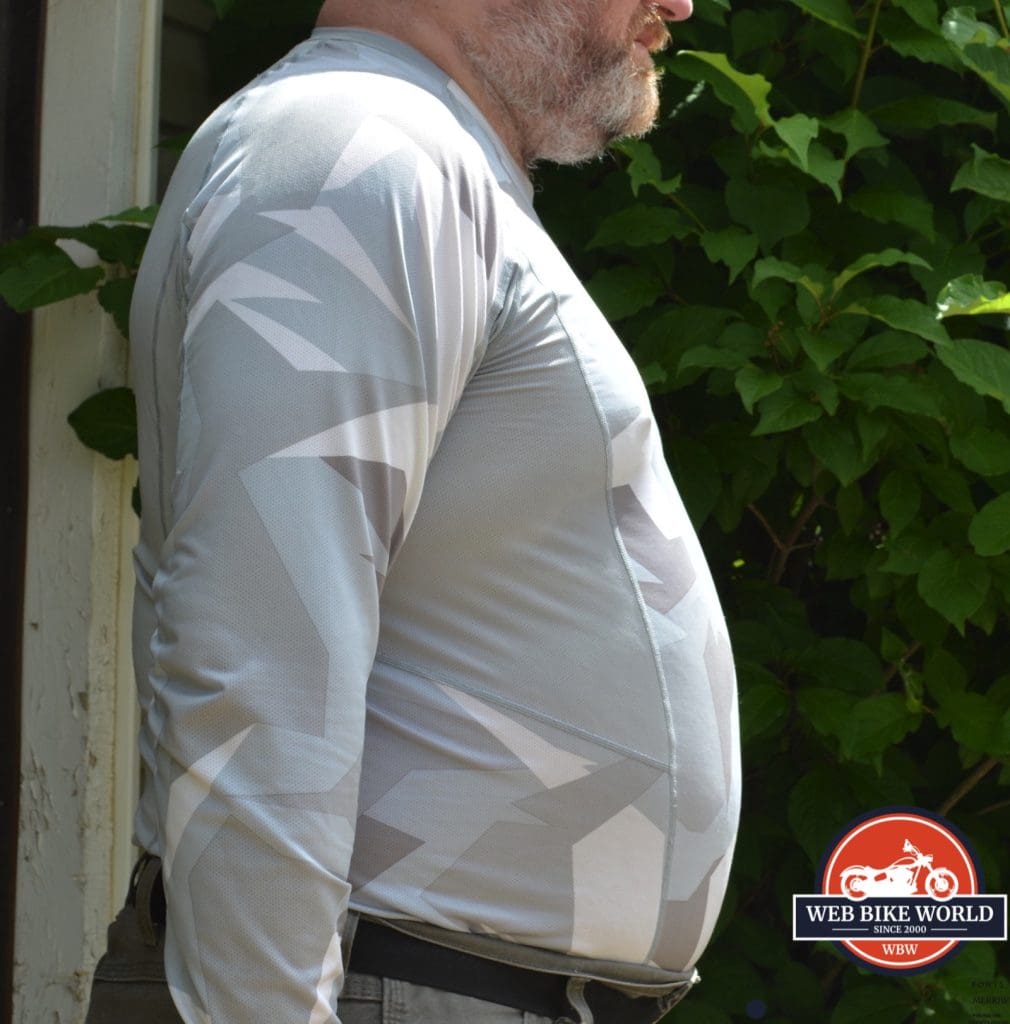
To name them, these major body radiators are the chest, the back, and the underarms. In other areas, such as down the arms, the fabric was a bit looser around the skin, and the collar left my neck more than enough room to fit a neck gaiter, a bandanna, a balaclava, or any other neck/head coverage item that may be used in powersports.
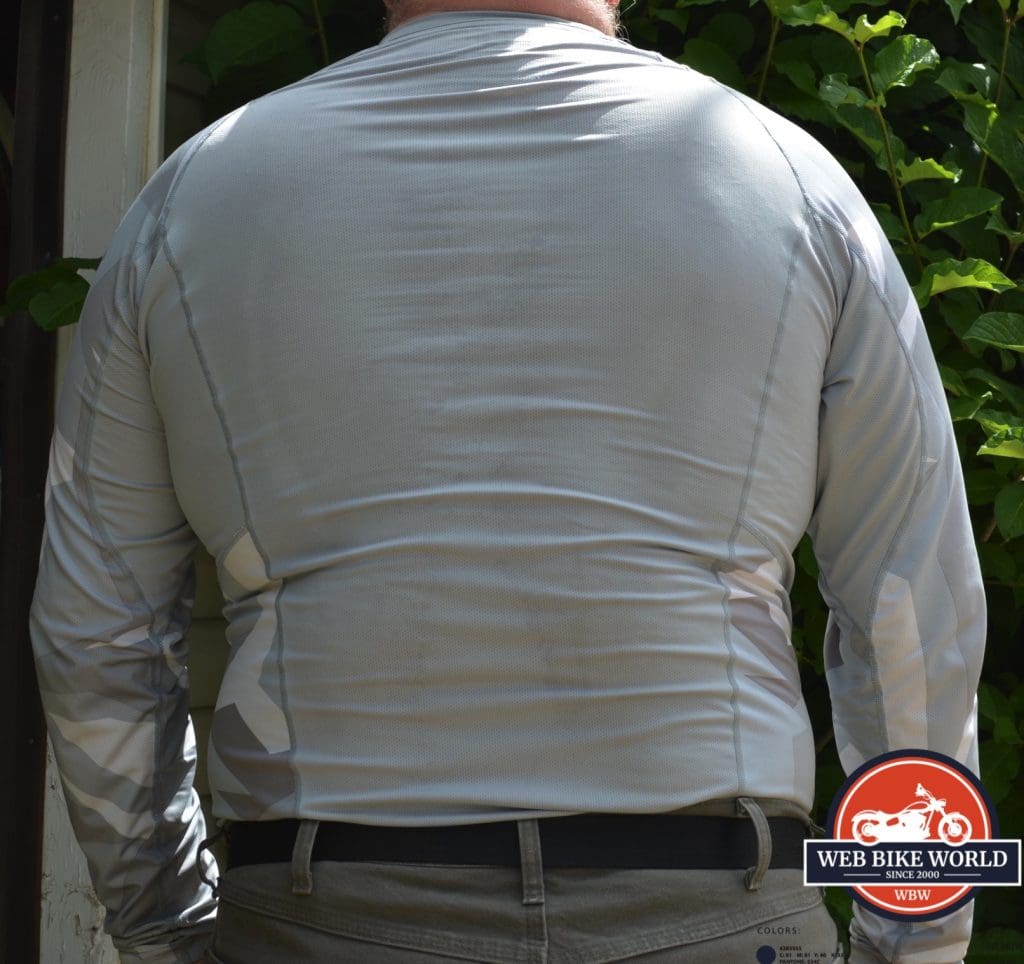
The only area I found the fit to be a bit too big was down at the wrists, as you can see in the picture below, with the shirt gathering around the base of my hand. However, this didn’t have any negative effects, as the CoolCore fabric is thin enough that it doesn’t interfere with the wrists of any jacket I own and can even be tucked into the base of any of my gloves if I want to add a little hand warmth to the cooling effect.
KLIM Aggressor -1.0 Cooling Shirt Ventilation
You may need to open the picture below in another window and zoom in to truly see it, but the KLIM Aggressor -1.0 has so many ventilation “pores” that air easily moves through them. When combined with the natural wind of riding a motorcycle passing through ventilation holes or the mesh parts of a jacket, the shirt sometimes feels like it’s not even there, and you’re getting the full effect of the wind.
KLIM Aggressor -1.0 Cooling Shirt Real-World Testing
Throughout the month of June 2021, Calgary experienced what could be considered “ridiculous” swings in temperatures. One day, it could be 15 C (59 F) outside, and I’d go riding in my Alpinestars Andes V3 touring jacket with the vents wide open and be comfortable. Other days, it would get close to 30 C (86F) like in the picture below, and my Rev’It Arc Air mesh jacket was my primary.
For the first week, I tested the shirt just as that, a shirt I wore under my jackets. Calgary is prone to winds, sometimes gentle, sometimes gusting, and through it all, I never felt like I was too hot or too cold. Even when riding at 110 KPH (68 MPH) into a headwind on the city’s expressway ring road, I never got to the point of actually being chilled.
In fact, in that example, the air temperature was about 24 C (75 F), but the wind was cold and headed down off the mountains. At first, I could feel the wind penetrate the mesh of my jacket, then the pores of the Aggressor -1.0, and wick heat directly away from my skin. However, about 3 minutes later, as I just had a thought at the very edge of my mind that my skin was getting a touch cold, the shirt felt like it was warming me up instead of cooling me down.
After thinking about it, what I think happened was that the shirt, with its special CoolCore fabric, had soaked up enough heat that when my body was falling outside its wicking range, was dumping the heat back into my skin. It wasn’t much heat, but it kept me comfortable enough that I found that ride to be quite pleasant, in fact.
However, in the last 1.5 weeks of June, Calgary (and the entirety of the Pacific Northwest Region of North America) went through a hellacious heat wave. Seasonal temperatures for Calgary at this time of year are between 23 and 27 C (73 F to 81 F), with a day or two spiking over 30 C (about 90 F). However, for this period, Calgary hit daily averages of 33 to 37 C (91.5 to 99 F). In other words, it was bloody hot.
Ever the diligent tester, I decided, of course, on the day that the temperature topped out at 38 C (about 100 F) to test something KLIM themselves recommend you do on extremely hot days. I cleaned out my bathroom sink, filled it with cold water, and dunked the shirt into that cold water. I let it sit for 5 minutes to get absolutely sodden while I put on my leg armor, riding pants, boots, et al. I then picked the shirt up out of the water and, without wringing it out, put it on. I then quickly put on my mesh jacket and helmet and got on the road less than 4 minutes later.
To say that the effect was amazing is understating it. For the first minute or so, it felt like I was wearing a shirt made out of dry ice, but once the warm air had started to flow over it, I could physically feel the temperature difference between my legs and my torso. Due to the massive amount of sweat I was pouring out and the fact it had soaked up all the cold water before, I was able to ride for about 70 minutes in complete comfort.
However, once the water had evaporated enough that the hot air, even at speed, was starting to push through the shirt, I started to feel hot and made the call to head home. Once home, I took off my mesh jacket, and the Aggressor -1.0 was almost bone dry on the outside but was starting to soak up the sweat from my skin like a sponge. This made me discover one of the only downsides I could find with the shirt.
If you get to your destination or home and want to remove the Aggressor -1.0, let it finish its soaking up of sweat or try to arrive completely dry. If you try to pull it off while it’s absorbing, it’s like trying to pull apart velcro, especially on the super-absorbent back panel. I found it easier to roll the body up and just give it a good tug over the head, but even that sometimes was tricky if it wasn’t done soaking up all the water.
During my testing, this also led to the only other downside. The shirt is washable with gentle detergent or as part of a load but must be washed in cold water, and it is highly emphasized that you do not machine or tumble dry the shirt, as that could affect the fibers. To dry it, either after wearing it or washing it, you need to hang it to dry. If you’re hoping to be able to use the shirt day today and don’t plan ahead, this could leave you with putting on a somewhat wet shirt or not wearing it at all.
Final Thoughts: The Coolest Shirt I Own
I am thoroughly impressed with the KLIM Aggressor -1.0 Cooling Shirt. It does exactly what it says on the label, and it does it in such a way that you don’t even notice it working 99% of the time. It fits true to the KLIM sizing guide and is eminently comfortable against the skin with the lie-flat stitching and the elastic nature of a compression shirt.
It will work donning it dry or, following KLIM’s own advice, soaking it in cold water before a particularly hot ride. It works under touring jackets with minimal ventilation, under mesh jackets with massive ventilation, and I would expect under any kind of jacket in between. As long as it has some way to evaporate off heat and have it carried away, this shirt will keep you cool and comfortable.
It does start to lose effectiveness the closer the outside temperature comes to body temperature. However, it will still cool you down enough to get those last few miles to a shaded place or a building with air conditioning, and once in those environments, will dump the heat it has gathered to the external environment.
Added to that is the fact that there are no chemical agents used to help in the heat transfer or cooling effect, and I cannot speak highly enough of this shirt. With the pandemic pounds, I retain heat a lot more than I used to, and even then, the Aggressor -1.0 has kept me comfortable on my rides. It is rare for an item to impress me so much that I think it may be the best in class of its specific market sector, yet KLIM has made a piece of cooling gear that has done just that. Just make sure that you pair it with a suitable hot weather jacket!
I have no reservations at all, through both objective and subjective observations, in giving the KLIM Aggressor -1.0 Cooling Shirt 4.5 out of 5 stars.
Pros
- No chemical agents used during cooling
- Compression fit, keeping it tight to your skin for optimal cooling
- Machine washable
- Does not lose any cooling functionality after washing
- Comfort-fit seams sit flush and comfortable against the skin
- Can hold a surprising amount of water in its fibers
Cons
- Can be a bit difficult to get off after a particularly hot ride as the absorbent fibers act almost like velcro against your skin
- Must be air-dried after washing or wearing, which can delay use.


